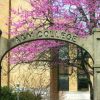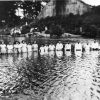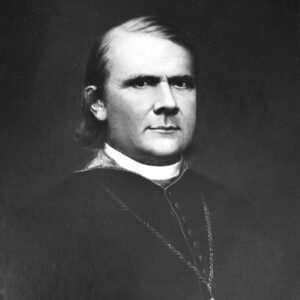calsfoundation@cals.org
St. Andrew's College
St. Andrew’s College, located near Fort Smith (Sebastian County), was the first attempt to found a Roman Catholic college in Arkansas. It was established in 1849 by Irish native Andrew Byrne, the first bishop of the Diocese of Little Rock. Byrne never had more than ten priests in Arkansas, and he maintained the Church with funds from the Austrian-based Leopoldine society and the French-based Society for the Propagation of the Faith. With this support, Byrne purchased land near Fort Smith to found the first Catholic college in Arkansas. When later incorporated into Fort Smith, the area was known as the “Catholic mile.” It was bordered on the north by Grand Avenue, on the south by Dodson Avenue, and on the east by Greenwood Avenue; the western boundary was Towson Avenue.
Byrne began pushing for a charter for his school in 1848, and the Arkansas General Assembly chartered the institution in early 1849 only after the Arkansas bishop agreed to add more laypersons, Catholic and non-Catholic, to the board of trustees. This was done to allay fears that this new college would be controlled by a “foreign potentate, the Pope of Rome.” The school opened in the fall of 1849, and Byrne wrote in the 1850 Metropolitan Catholic Almanac that the school had Father John Monaghan as president, with five other professors. This description also reported that there was a small “Ecclesiastical Seminary” on the grounds and that the college was “chartered by the last Legislature of Arkansas, with all powers granted to Universities.” The number of students who attended St. Andrew’s is unknown. By the end of the decade, a Fr. Thomas Donovan was the college’s president. As with most colleges in the nineteenth century, St. Andrew’s College was for men only.
St. Andrew’s apparently did not survive past 1860. An 1860 report stated that the “pressing calls of the faithful for the Ministry” and the “scarcity of Clergy-Men, have obliged the bishop to suspend…the duties of the College.” The 1861 Catholic Almanac failed to mention the school’s existence. Byrne died on June 10, 1862, never having reopened St. Andrew’s. Indeed, by 1860, there were only eight priests in the state, and Catholics numbered only around one percent of the population, rendering it difficult to sustain a Catholic college.
This would not be last attempt to found a Catholic college in Arkansas. Arkansas’s third Catholic bishop, John B. Morris, opened Little Rock College in 1908, though it closed in 1930.
For additional information:
Archives of the Diocese of Little Rock. St. John’s Catholic Center, Little Rock, Arkansas.
Woods, James M. Mission and Memory: A History of the Catholic Church in Arkansas. Little Rock: August House Publishing, 1993.
James M. Woods
Georgia Southern University
 Education, Higher
Education, Higher Louisiana Purchase through Early Statehood, 1803 through 1860
Louisiana Purchase through Early Statehood, 1803 through 1860 Lucey, John Michael
Lucey, John Michael Religion
Religion Andrew Byrne
Andrew Byrne 




Comments
No comments on this entry yet.